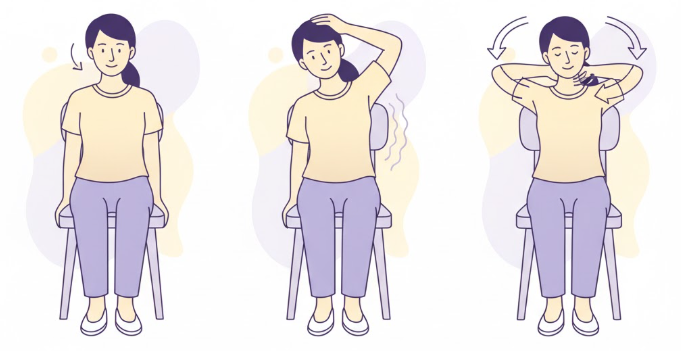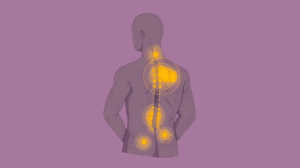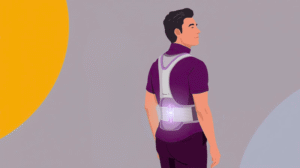Growing use of smartphones is coming with a lot of pain points with neck discomfort being the one. Stiffness and headaches are now becoming more common among people of all ages. Hence, adopting smarter tech habits is important and this can be done by performing simple exercises daily.
For more such quick tips, check these out:
- https://betterhood.in/learn/musculoskeletal-recovery-tips-for-pain-relief/
- https://betterhood.in/learn/how-can-pain-relief-patches-help-you-manage-muscle/
Why “Text Neck” Is the New Modern Health Challenge?
The Surprising Surge of Neck Pain in Smartphone Users
In the digital age, our necks are working overtime; and they’re not thrilled about it. “Text neck syndrome” affects all age groups, but the surge among smartphone users is especially dramatic. About 70% of young adults experience neck and shoulder pain tied to their tech habits [1]; if your phone is glued to your hand, you may unknowingly be auditioning for the next episode of “Knots and Numbness.” A study from India found 46% of college students reported neck pain with over four hours of daily phone use. That’s a lot of time spent doomscrolling and dodging calls from relatives.
Key Statistics: India’s Smartphone Usage & Neck Pain
- 46% of college students in India report neck pain related to smartphone use over 4 hours a day [2].
- Smartphone use is now linked to more than double the risk of chronic neck pain.
- Cases of neck pain and stiffness are growing year-on-year due to device overuse; sometimes leading to mild disability and reduced quality of life.
- In one survey, most reported pain at the base of the neck, radiating toward the head and shoulders.
- Medical students suffering “text neck” often struggle with daily tasks even after graduation [3].
What Is “Text Neck” Syndrome?
“Text neck” isn’t just a trending hashtag; it’s a clinically recognized condition caused by flexing your neck forward for long periods while using mobile devices. The stress of this unnatural posture puts pressure on the cervical spine, muscles, and ligaments, causing a predictable cycle of soreness, headaches, and even nerve pain. When your head tilts forward 60 degrees (think: phone at chest level), the pressure on your neck can jump to 60 pounds; roughly the weight of a large dog. No wonder Fido wants more respect.
Classic Symptoms to Watch Out For
- Soreness and difficulty moving the neck.
- Dull, aching, or even sharp pain in the lower neck.
- Radiating discomfort into shoulders and arms [4].
- Tension headaches; especially at the base of the skull.
- Decreased flexibility and neck range of motion.
- Numbness or tingling in arms/hands.
- Worsening posture (cue the “hunched-over-zombie” look).
- Sleep disturbances from neck/shoulder pain.
- In severe cases, there’s risk of spinal degeneration, early arthritis, or disc compression.
Understanding Neck Pain Causes
Tech Habits that Harm Your Neck
It’s not just binge-watching or competitive WhatsApp texting; habitual phone use can distort your posture worse than a plot twist in a soap opera. Every degree your head tilts forward multiplies stress on cervical muscles.
Looking Down: The Physics of Phone Posture
- Each inch forward tilting the head increases the effective weight the neck must bear.
- At 15°: 27 pounds; at 30°: 40 pounds; at 45°: 49 pounds; at 60°: 60 pounds.
- Over time, these bad mechanics lead to muscle fatigue, tightness, and even inflammation.

All-Day Messaging? Micro-breaks You’re Missing
- Most people skip breaks, leading to “creep” in neck ligaments; where tissues stretch, lose tension, and make the next boring group chat even harder to survive.
- Micro-breaks (standing, rolling shoulders, stretching) every 20-30 minutes are proven to reduce musculoskeletal complaints.
Beyond Phones: Other Everyday Triggers
It’s not all screens! Other neck pain villains include:
- Sleeping with a non-supportive pillow.
- Lounging on soft sofas for hours.
- Carrying heavy bags on one shoulder (looking stylish, feeling sore).
- Long computer sessions with poor ergonomics.
- Skipping regular stretching or physical activity.
- Chronic stress, anxiety, and poor hydration.
If your neck feels 20 years older than the rest of you, it’s probably not just the memes you consume.
Immediate Relief: Quick Neck Pain Exercises at Home
One-Minute Warm-Up: Prepping Your Muscles
Cold muscles are stubborn; doing a quick warm-up pays off. Try:
- Slow, gentle neck rotations (left, right, up, down) [5].
- Shoulder rolls and shrugs for 30 seconds.
- Soft massage around the base of the skull.
This boosts blood flow and prevents the dreaded “crackly” feeling (no, it’s not Rice Krispies in your spine).
Top 5 Neck Pain Exercises for Smartphone Users
Chin Tucks at Your Desk
- Sit or stand tall, gently pull your chin straight back (not down), making a “double chin” (just for a few seconds; it won’t get stuck this way).
- Hold for 5 seconds, repeat 10-15 times.
- Scholarly evidence shows chin tucks strengthen deep cervical flexors, reduce pain, and improve posture [6].
Side Bends for Instant Neck Release
- Tilt your head toward your shoulder (ear to shoulder), hold 10 seconds, repeat both sides, 8-10 reps each.
- This releases common tension points in the tech neck.
Seated Shoulder Blade Squeezes
- Sit upright, squeeze shoulder blades together, hold 5 seconds, release.
- Repeat 15 times. This muscular hug relieves upper back and neck strain.
Gentle Head Rotations
- Turn your head slowly left, hold, then right, hold.
- Enhance flexibility without the risk of accidentally discovering a hidden pop-and-lock dance move.
Neck Extensions (the Right Way)
- Look gently upward (not straining), then return to neutral.
- Repeat slowly; this counters forward neck stress.
- No “whiplash” moves-remember, bobbleheads are not the goal.
Bonus: Neck and Shoulder Pain Combo Relief Moves
- Use resistance stretch bands (light resistance) for extra strengthening once basic moves are comfortable.
- Try applying a hot pack for 10-15 minutes after exercising to relax tight muscles, especially after a long Instagram binge.
Tips:
- Do these exercises 2-3 times daily for best results; don’t just wait for pain to strike.
Preventing Recurrent Neck Pain
Daily Habits Beyond Exercise
Smartphone Ergonomics: Level Up Your Grip
- Hold your device at eye level (imitate the “thinking philosopher,” minus the marble bust).
- Use both hands and switch up the grip regularly.
- Try voice-to-text tools to reduce awkward hand positions.
Neck-Friendly Sleep Tips and Pillow Advice
- Use a pillow that supports the neck’s natural curve, neither too thick nor too thin [7].
- Sleep on your side or back for best results.
- Avoid stomach sleeping unless you enjoy waking up as a pretzel.
Lifestyle Tweaks for Lasting Comfort
Scheduled Phone Breaks: How Often?
- Set a timer every 30 minutes to stand, stretch, or simply look at a wall; if nothing else, your neck will thank you for the scenery change.
- Employ “20-20-20” rule: every 20 minutes, glance 20 feet away for 20 seconds.
Easy Desk Upgrades That Make a Difference
- Keep screens at eye level (stack some old textbooks or buy a monitor riser).
- Use ergonomic chairs, ideally with head and lumbar support.
- Keyboard and mouse should be at a comfortable height, minimizing shoulder and wrist strain.
Additional Habits to Consider
- Maintain upright posture, whether seated or standing.
- Stay hydrated and take frequent stretch breaks.
- Regularly check posture in the mirror (or ask your most brutally honest friend).
When to See a Doctor (Not Just Google)
Serious Neck Pain Symptoms That Need Attention
Pain happens, but chronic pain is not worth toughing out. Watch for:
Chronic Pain, Numbness, or Headaches?
- Pain lasting several weeks
- Numbness or tingling in arms or hands
- Weakness or loss of grip strength
- Persistent headaches, especially at the base of the skull
- Sudden, severe pain after injury
“Google” may offer sympathy, but it won’t fix nerve damage. Seek medical advice promptly for these symptoms.
Finding a Neck Pain Doctor Near You
- A physiotherapist or orthopedic specialist can help with personalized management plans, physical therapy, or advanced treatments.
- Chronic pain or disability (can’t turn your head past “NOPE!”) warrants evaluation “offline” by pros.
End Note
Your neck is the unsung hero of your digital life. But don’t let tech neck turn you into a cyborg; adopting healthy tech habits and practicing regular neck exercises is better than a lifetime supply of painkillers or a relationship with your local chiropractor. You can do stretches for at least five minutes in a day to feel the difference.
Moreover, persistent neck pain can lead to real physical issues and reduced quality of life. Quick tips: Hold your phone higher. Stretch often. Sleep smarter. And, most importantly, remember your spine loves variety as much as your taste in memes.
Frequently Asked Questions:
1. What are the early symptoms of “text neck”?
Early signs include stiffness, pain at the base of your neck, limited rotation, and headaches after long phone sessions. If your neck feels like it’s been drafted into manual labor, you might have a text neck.
2. Which exercise works fastest for phone-related neck pain?
Chin tucks and shoulder blade squeezes can relieve acute pain in minutes and are supported by research for quick improvement in posture and pain.
3. Can smartphone habits really cause lasting neck problems?
Yes; and it’s not just temporary discomfort. Long-term poor posture can trigger disc compression, nerve damage, and even early arthritis, according to multiple clinical studies.
4. When should you consult a doctor for neck pain?
If pain, numbness, or headaches last more than a few weeks, worsen with time, or bring tingling/weakness in hands, you should seek professional evaluation.
5. Are special pillows or accessories needed for tech-induced neck pain?
A pillow that supports the neck’s natural curve helps, but no device replaces the benefits of consistent stretching, tech breaks, and posture awareness.
References
- Piruta, J., & Kułak, W. (2025). Physiotherapy in Text Neck Syndrome: A Scoping Review of Current Evidence and Future Directions. Journal of Clinical Medicine, 14(4), 1386. https://doi.org/10.3390/jcm14041386
- Salameh, M. A., Boyajian, S. D., Amaireh, E. A., Jamal, B., Alrfooh, H., AbuKhalaf, K., … & Alzyoud, K. (2024). Prevalence of text neck syndrome, its impact on neck dysfunction, and its associated factors among medical students: A cross-sectional study. Work, 79(3), 1111-1119. https://doi.org/10.3233/WOR-230678
- Tsantili, A. R., Chrysikos, D., & Troupis, T. (2022). Text neck syndrome: disentangling a new epidemic. Acta medica academica, 51(2), 123. doi: 10.5644/ama2006-124.380
- Mayo Clinic News Network (2024). Tech neck is a pain in more than just the neck. Retrieved from: https://newsnetwork.mayoclinic.org/discussion/tech-neck-is-a-pain-in-more-than-just-the-neck/ [Viewed on 25 October 2025]
- WebMD (2024). Neck Stretches and Exercises for Pain Relief. Retrieved from: https://www.webmd.com/fitness-exercise/fitness-neck-stretches [Viewed on 25 October 2025]
- Shin, C. H., & Shin, S. M. (2023). Effects of Neck Flexor Training Program on Cervical Spine Normalization, Muscle Strength, and Pain in Women. Asia-pacific Journal of Convergent Research Interchange (APJCRI), 449-460. http://dx.doi.org/10.47116/apjcri.2023.09.34
- Kim, M. R., Chung, J. Y., Lee, D. Y., Hong, J. H., Kim, J. S., Yu, J. H., & Jung, S. (2016). The influence of pillow material and shape on cervical curvature stability. Indian J Sci Technol, 9(47). DOI: 10.17485/ijst/2016/v9i47/108373























